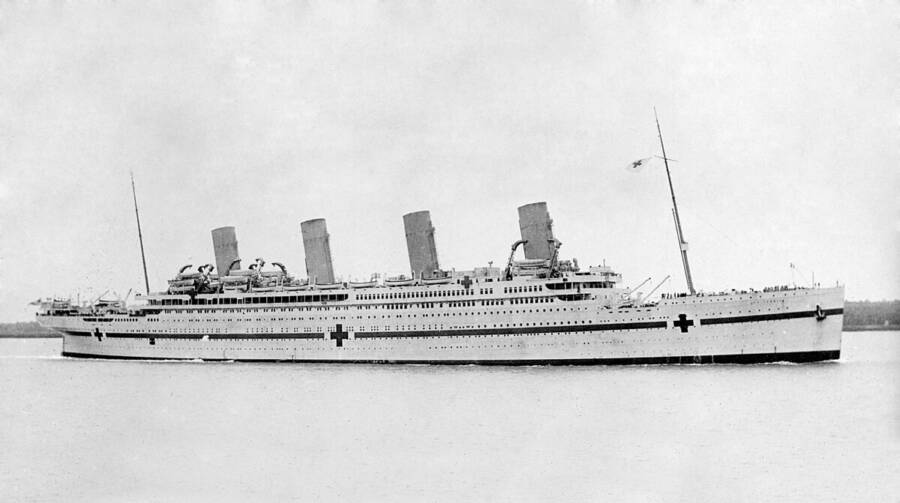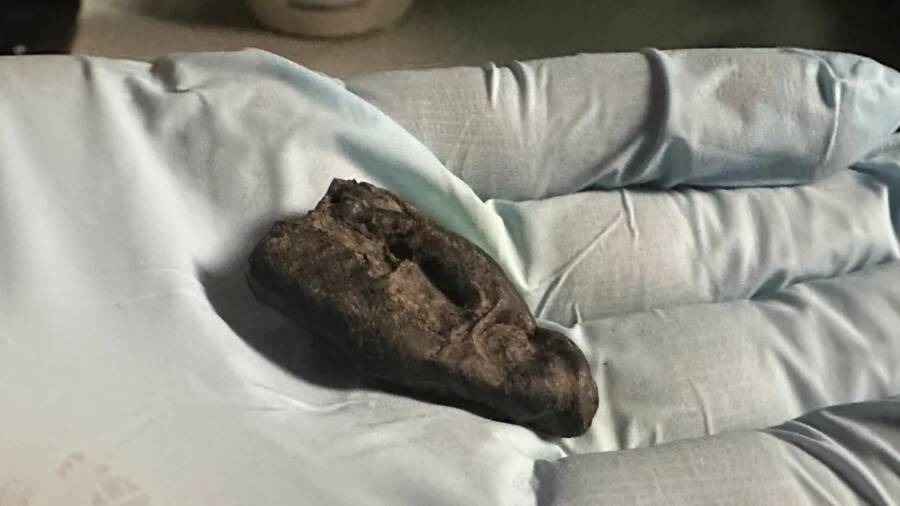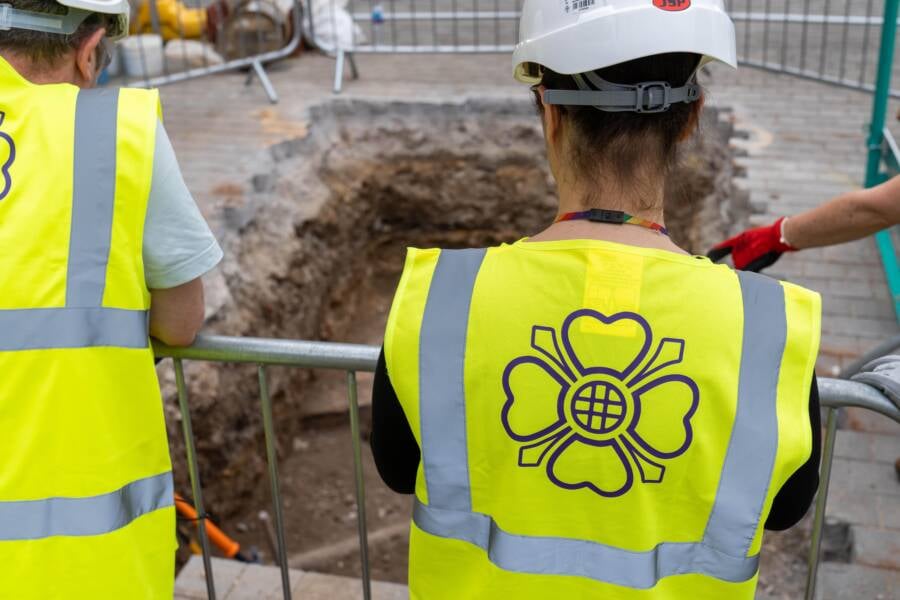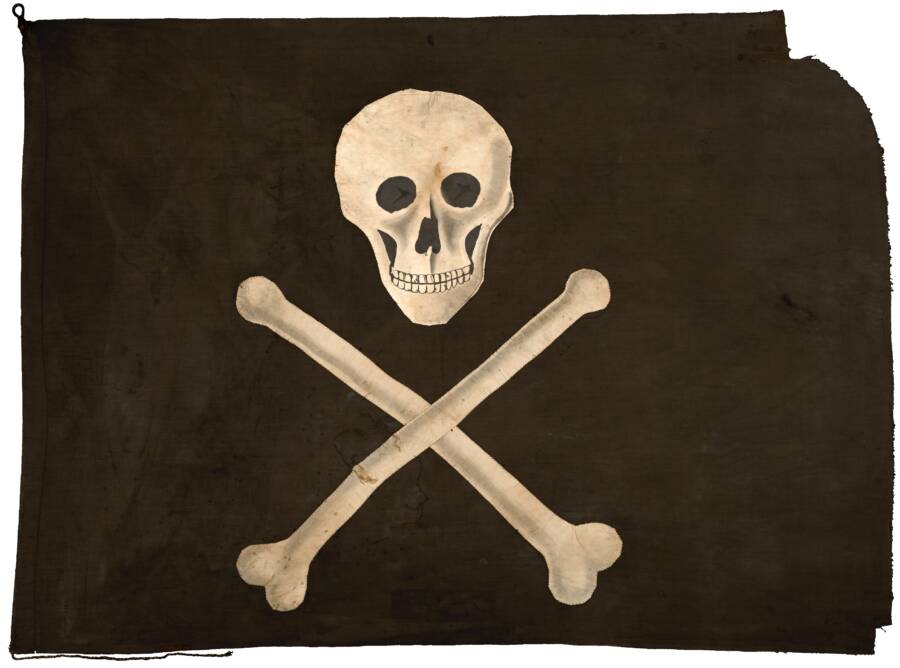
ALLTHATSINTERESTING.COM
What Happened To The HMHS Britannic, The White Star Line Ship That Sank Four Years After The Titanic?
Wikimedia CommonsThe HMHS Britannic was converted to a hospital ship during World War I.History is full of infamous shipwrecks. One of the most well-known wrecks is from the Titanic disaster that occurred in 1912. But the Titanic was not an only child. White Star Line, the British shipping company behind the Titanic, also commissioned two other luxurious ocean liners around the same time, the Olympic and the Britannic. The Olympic narrowly escaped tragedy twice before being retired and sold for scrap, but the Britannic would unfortunately meet an untimely demise like the Titanic, also sinking to the bottom of the sea. However, the Britannic is far more hidden in the depths of history than its famous sister. Lets dive into the story of the often-overlooked Britannic, which met a tragic fate after striking a German mine in the Aegean Sea on Nov. 21, 1916.The Commissioning Of The Titanic, The Olympic, And The BritannicWikimedia CommonsThe Olympic and the Britannic in the same Belfast shipyard.The Britannic was the sister ship of the Titanic and the Olympic. The White Star Line ships were meant to be competitors of Cunard Lines Lusitania and Mauretania, in terms of both safety and luxury. The three White Star Line ships were commissioned by J. Bruce Ismay, the chairman and managing director of the shipping company. The Olympic and the Titanic were built first, with construction on the Olympic beginning in 1908 and construction on the Titanic starting in 1909.The ships were so massive that only two of them could be built at a time in a special gantry at the Harland and Wolff shipyard in Belfast, Ireland.Wikimedia CommonsThe Britannic under construction.The ocean liners were meant to complete a transatlantic journey in about a week or so. While they were not as fast as other competing ships, like the Lusitania, they were arguably more lavish and elegant. Rumors spread that the Britannic was initially given the name Gigantic, but White Star Line insisted that the ship was always meant to be named Britannic. Still, gossip persisted that its name was changed in order to not create comparisons or compete with its sister ship, the Titanic. Inside The Construction Of The BritannicWikimedia CommonsThe Britannic, shortly before it was launched.Construction on the Britannic didnt begin until three years after work on the Olympic began. Builders started working on the Britannic in November 1911, shortly before the Titanics infamous disaster in April 1912. Like the Olympic and the Titanic, the Britannic was built at the Harland and Wolff shipyard. After the tragic sinking of the Titanic, many changes were made to the Britannics design to ensure it would be safer than its sibling.These changes included increasing the ships beam to 94 feet, adding to the overall width of the vessel, and using higher-rated horsepower.The number of watertight compartments was also increased, and crucially, more lifeboats were added. There were 48 lifeboats on board, far more than the Titanics 20 lifeboats, and the Britannics lifeboats had more than enough room for all its passengers, even if the ship was at maximum capacity.The Britannic was officially launched on Feb. 26, 1914. Meant To Be A Passenger Ship, The Britannic Enters World War I InsteadWikimedia CommonsThe HMHS Britannics boat deck.Before the Britannic could begin its regular transatlantic voyages as a commercial vessel, World War I broke out in Europe. Because of this, the Britannic and other liners were requisitioned by the British government.Since the Britannic was larger than many other vessels and a little more challenging to operate, it was converted to a hospital ship.Slightly renamed to HMHS (His Majestys Hospital Ship) Britannic, the vessel was outfitted with extra davits capable of holding even more lifeboats than the ship already had onboard, and the ships dining rooms were transformed into spaces where medical operations could be completed. The ship was also repainted, now sporting a horizontal green stripe and three large red crosses down each side, so it would be clear it was a vessel where wounded soldiers could be treated not one that would fight in battle. By late 1915, the ship was declared fit for service during the war.Wikimedia CommonsA funnel for the HMHS Britannic being transported. On Dec. 23, 1915, the HMHS Britannic embarked on its maiden voyage, sailing from Liverpool, England, to the Greek island of Lemnos. There, the vessel picked up over 3,000 injured and sick British soldiers, then brought them back to Southampton, England. The medical staff aboard treated them throughout the journey and kept them as comfortable as they could.Along with making voyages to pick up wounded soldiers, the HMHS Britannic also spent a few weeks serving as a floating hospital near the Isle of Wight. The vessel was supposed to be released from war duty in June 1916, but it was soon called back to duty as World War I dragged on.The Ships Final Voyage Ended With An ExplosionWikimedia CommonsA New York Times headline about the Britannics sinking. Though the ship was initially thought by some to be the victim of a torpedo, evidence later showed that a mine was responsible for the explosion on board.The HMHS Britannics sixth and final voyage began on Nov. 12, 1916. This time, the ship and its crew were headed back to Lemnos once again. There were 1,066 people on board for this journey, including 673 crew members, 315 Royal Army Medical Corps, 77 nurses, and the captain. The ship made it to a scheduled stop in Naples for coaling. But at the same time, a storm was brewing in the region, forcing the vessel to stay in Naples until a small storm break allowed the liner to continue its mission.While still en route to Lemnos in the Aegean Sea, the HMHS Britannic accidentally hit a German naval mine on Nov. 21, 1916. The resulting explosion, which happened shortly after 8 a.m., caused significant damage to the vessel, which was then located near the island of Kea. Even though some of the watertight compartments flooded, the ship initially seemed capable of staying afloat at least for the time being. The captain, Charles Bartlett, hoped to beach the damaged ship off Kea, so he fatefully ordered the crew to move toward the island at full speed.Unfortunately, this move only caused more water to enter the vessel.By this point, Bartlett had already sent out distress signals, but he was perplexed as to why hed gotten no response from any nearby ships. Unbeknownst to the crew at the time, the explosion had severely damaged the ships antenna wires. While the ship could still send out signals, they could no longer receive them, so they had no idea when help would arrive.And chillingly, it soon became clear that the vessel was doomed.Thanks To Quick Thinking, Most Of The Passengers SurvivedWikimedia CommonsSurvivors of the Britannic, pictured on the HMS Scourge.Captain Charles Bartlett quickly realized that the HMHS Britannic was reaching its flooding limit, and it wouldnt be long before the vessel was in the same condition that the Titanic was in after hitting the infamous iceberg. Bartlett moved quickly to help people evacuate the ship. Tragically, some onboard began to board lifeboats without Bartletts permission, and when they lowered into the water using automatic lowering gear, the lifeboats were sucked into the ships massive, still-spinning propellers.This led to horrifically gruesome deaths for people on two lifeboats. A third lifeboat came dangerously close to the same terrible fate, but fortunately, Bartlett gave the order for the engines to be stopped just in time. The lucky people onboard that lifeboat were able to successfully push away from the now-static propellors that had already claimed lives.Violet Jessop, who survived both the Titanic and the Britannic, later wrote of her near-death experience while escaping the Britannic sinking: I leapt into the water but was sucked under the ships keel which struck my head. I escaped, but years later when I went to my doctor because of a lot of headaches, he discovered I had once sustained a fracture of the skull!Before long, the official order was given for the lifeboats to be lowered, and within an hour after the ship hit the mine, most of the people onboard had been evacuated. Though Bartlett fervently tried to find some way to save the ship after saving the passengers, it soon became clear that he would have to abandon the HMHS Britannic, as it continued sinking into the water.As it turned out, Bartlett was able to step directly into the sea and then swim to one of the lifeboats in the water. Meanwhile, the doomed vessel continued to sink. By 9:07 a.m., it had slipped below the waves less than an hour after the fateful explosion had happened onboard.The Discovery Of The Britannic Wreck And The Exploration That FollowedGreek Ministry Of CultureA diver exploring the wreck of the HMHS Britannic, which lies at the bottom of the Aegean Sea near Kea.Compared to the wreck of the Titanic, the Britannic had a much smoother and much more successful rescue. Of the 1,066 people on board the Britannic, 1,036 people survived the sinking. Tragically, 30 people perished, but the death toll was far lower than that of the Titanic, which saw about 1,500 deaths and only 706 survivors during its sinking.Aside from the quick thinking of the Britannics captain and the prompt evacuation of the vessel, the rescue was also aided by the fact that the Britannic was far closer to land than the Titanic, there were more ships in the surrounding area, and the water temperature was warmer in the Aegean Sea than in the North Atlantic, where the Titanic had met its fate.The wreck of the Britannic was discovered in 1975 by Jacques Cousteau, a French ocean explorer and the co-inventor of the Aqua-Lung. Since then, the wreck has been visited a number of times, but only by the most experienced and most highly-qualified researchers and diving crews.It was only in 2025 that divers with the Greek Ministry Of Culture announced that they had recovered artifacts from the Britannic wreck for the first time ever. One of the most exciting items pulled from the Britannic wreck was the ships lookout bell, but other objects included one of the vessels navigation lamps, ceramic tiles from a Turkish bath, and a pair of binoculars.While the Britannic will never be as infamous as its sister, the Titanic, its notoriety has gradually increased following the discovery of its wreck. The last survivor of the Britannic, George Perman, died on May 24, 2000, just short of his 100th birthday. He had been just 15 when the ship sank. After reading about the sinking of the HMHS Britannic and the wreck left behind, discover the stories of more astonishing shipwrecks around the world. Then, go inside the chilling stories of ghost ships from history.The post What Happened To The HMHS <em>Britannic</em>, The White Star Line Ship That Sank Four Years After The <em>Titanic</em>? appeared first on All That's Interesting.
0 Kommentare
0 Geteilt
9 Ansichten












